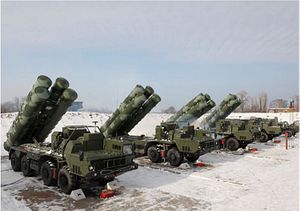The People’s Liberation Army’s Rocket Force (PLARF) has conducted its first live fire drill of its newly acquired first regimental set of Russian-made S-400 Triumf long-range interceptor-based air defense systems (NATO reporting name: SA-21 Growler), according to Russian media reports.
The test purportedly took place in November at an undisclosed location. According to the report, the S-400 air defense systems intercepted a “simulated ballistic target” around 250 kilometers (155 miles) away. According to the report, the PLARF actively used jamming equipment to test the S-400’s ability to operate in an electronic warfare environment.
None of the information above could be independently verified.
The S-400 air defense system is reportedly capable of engaging up to 36 targets simultaneously including stand-off jammer aircraft, Airborne Warning and Control System (AWACS) aircraft, and both ballistic and cruise missiles. As I explained previously:
In comparison to its predecessor, the S-300, the S-400 air defense system features an improved radar system and updated software; it can purportedly fire four new types of surface-to-air (SAM) missiles in addition to the S-300’s 48N6E, a vertical tube launched, solid fuel, single stage SAM with an estimated range of 150 kilometers (93 miles), and the improved 48N6E2 missile with a reported range of 195 kilometers (121 miles).
(…)
The S-400 is also armed with an improved variant of the 48N6E2 with an alleged range of 250 kilometers (160 miles). The air defense system can also fire two additional missiles, the 9M96E and 9M96E2 with respective ranges of 40 km (25 miles) and 120 km (75 miles). Improved S-300 air defense systems such as the S-300PMU-2 Favorite … can purportedly also fire the 9M96E and 9M96E2.
The missile most likely used in the test is the 48N6DM/48N6E3, an upgraded variant of the 48N6E2. The 48N6DM/48N6E3 can reportedly reach top speeds of 4,800 meters per second, which is the same target velocity named in the Russian media report.
The missile, fitted with a solid fuel engine, a semi-active homing head, and capable of resisting intense clutter and jamming, is intended to engage intermediate-range ballistic missiles.
Notably, the test has so far not been publicly confirmed by the PLARF or other Chinese government entities. In July, Russian media reports indicated that the first test of the S-400 would take place within days.
The delivery of the 48N6E2 would also correspond with previous reports that the first regimental set of S-400 will be armed with that weapon system, while other regiments are expected to receive the 40N6E. (Russia first released details of the 40N6E, the export variant of the missile, during the 2018 Army Forum in August.)
China will reportedly receive a total of two S-400 regiments for an estimated $3 billion with the second regimental set expected to be delivered by the end of 2018. China was the first international customer to place an order for the Russian-made S-400 air defense system in 2014.
The U.S. imposed sanctions this September on the People’s Liberation Army’s (PLA) Equipment Development Department (EDD) for the procurement of S-400 air defense systems and Sukhoi Su-35S (NATO reporting name: Flanker-E) fighters.































